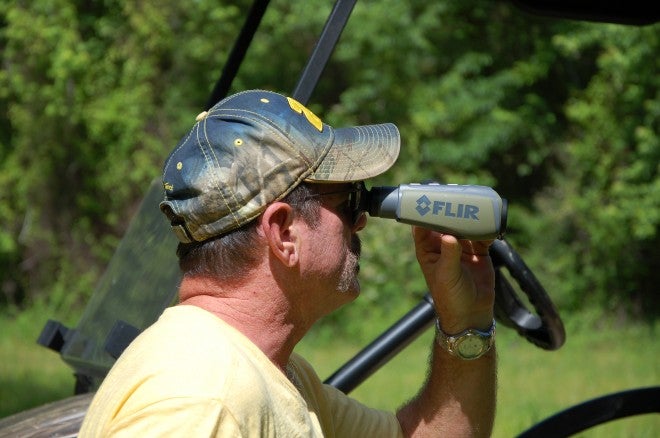Distinct Advantages of Thermal Imaging
Dr. John Woods 07.08.14

Seeing thermal images in the dark of night is cool. I was given the opportunity for a month to check out the FLIR Scout PS series handheld thermal imaging unit, and even in a limited product test mode, my mind was going wild conjuring up the multiple uses for such a tool. I wish it had been the open hunting season.
The more obvious uses for having thermal imaging capability include game management/herd surveys, wildlife observations, security, law enforcement applications, livestock farmers locating lost cows, campers and hikers traversing trails at night, tracking for downed game, and heat loss applications around residential or commercial buildings.
For hunters, the uses should seem more obvious. Walking or riding hunting areas at night just to survey game in the area has its own benefits. Anything that emits a heat signal will be picked up by the FLIR Scout. Checking out deer and other game would be awesome.
For hog hunters checking out baited sites at night, thermal imaging is perfect. It also works great for spying fields, food plots, and open trails for active game spotting. The Scout PS will spot man-sized targets out as far as 500 yards. It also works through light fog, smoke, or dust.
The Scout PS is a lightweight, handheld device similar to a monocular optical scope. The unit is held securely by an adjustable hand strap like a compact video camera. It is easy to use and hold steady, and it’s very portable at only 12 ounces. The unit recharges via a supplied USB cable.
The unit itself is ruggedly designed and covered in a soft cushion-like material that will take field bumps, but more importantly it’s really easy to grasp even when wet. The design was well thought out for the user in terms of ergonomics and gripability (if that’s a word).
The operational control buttons are on top of the unit in a row. Once the user learns which button does what, it becomes second nature to turn on and adjust. The FLIR web site has excellent tutorial video guides for learning to use the PS Thermal Camera.
The PS series thermal unit can “see” heat in two modes: white hot and black hot. In regular use I preferred the white hot mode. This simply means that the heat signature showing up on the screen is white, as opposed to everything else being white in the background while the heat object picked up is black. It’s a matter of personal preference I guess. The white hot mode seemed clearer to me and easier to see detail.
FLIR Scout units are in such high demand for product testing by writers that I only had a short time to use the unit in the field. I took the Scout to my hunting camp in Central Mississippi on an overnight trip. We built a huge fire in the campfire ring out in front of the cabins to give me a base of operation to work from.
Then I set out to walk down the main camp road. I switched on the unit and changed the imaging to the white hot mode. The PS immediately began to pick up heat signatures that I would not have expected. Though it was 9 PM, the tree line around camp was still emitting heat from the sunlight of the day. That was cool.
The campfire of course lit up the Scout viewing screen in red hot color. I could also easily see my campmate sitting in his chair by the fire. This was from over a hundred yards away. I picked up all types of heat escapes from the cabin as well.
I continued to stroll further from camp down the road. Next I spotted a small animal on the ground roughly 50 yards out in front of me. The image was so clear it was easy to determine the animal was a rabbit. Its entire body was shown in mostly bright white in the viewer, but in particular the rabbit’s eyes were a brilliant white.
I crept up closer and closer until I was within ten yards of it. My footsteps in the gravel road must have finally startled it as it ran into the woods. Neat. Next I heard a bird chirping up over my head, and when I put the PS on it, it too, appeared glowing white. This proved to me just how sensitive the FLIR-PS is.
Alas I did not spot any deer with the unit, but if they had been out, I am quite sure their heat visibility would have been spectacular. I learned enough with my limited testing time to appreciate the value of having the capability to read thermal images in the wild at night. Just imagine scouting for deer or hogs with a unit like this.
At a retail of $1,999, the FLIR PS would be a welcomed piece of gear for an outfitter, a game manager, or private landowners/individual hunters wanting to assess the status of game in their areas. The Scout PS would also be helpful in spotting trespassers or poachers where they should not be. Also if game were lost or wounded, the Scout would be great for those tracking efforts after dark. Thus, the FLIR Scout is certainly a recommended piece of high tech gear every hunter or landowner could use.